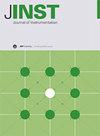Study of the thermal neutron activation of a gamma-ray detector for BNCT dose monitoring
IF 1.3
4区 工程技术
Q3 INSTRUMENTS & INSTRUMENTATION
引用次数: 0
Abstract
We present a study on the neutron activation of a gamma-ray detector for a BNCT-SPECT dose imaging system. The detector is based on a LaBr3(Ce+Sr) scintillator crystal, coupled with a matrix of Silicon Photomultipliers (SiPMs), read by a dedicated electronics system. This detector has successfully demonstrated to be capable to identify the 10B compounds when irradiating borated vials with thermal neutrons. However, a background signal around 478 keV was detected, suggesting the activation of the detector itself. This study aims to determine the origin of this background signal by simulating the two main parts of the detector, which are the crystal and electronic boards, in order to assess their contribution to the background signal. The results of the FLUKA simulations show that the neutron capture reactions on both the crystal and electronic boards cause a relevant background nearby the BNCT signal, thereby limiting the detector's sensitivity. To address this issue, a customized cadmium shielding has been developed. This solution was tested at the TRIGA Mark II research nuclear reactor of Pavia University, where experimental measurements and corresponding FLUKA simulations proved its effectiveness.用于 BNCT 剂量监测的伽马射线探测器的热中子活化研究
我们介绍了对用于 BNCT-SPECT 剂量成像系统的伽马射线探测器的中子活化研究。该探测器基于 LaBr3(Ce+Sr)闪烁晶体,与硅光电倍增管(SiPM)矩阵耦合,由专用电子系统读取。在用热中子辐照硼酸盐小瓶时,该探测器已成功证明能够识别 10B 化合物。然而,在 478 keV 附近检测到了一个背景信号,这表明探测器本身被激活了。本研究旨在通过模拟探测器的两个主要部分,即晶体和电子板,来评估它们对本底信号的贡献,从而确定本底信号的来源。FLUKA 模拟的结果表明,晶体和电子板上的中子俘获反应会在 BNCT 信号附近造成相关背景,从而限制探测器的灵敏度。为解决这一问题,开发了一种定制的镉屏蔽。该解决方案在帕维亚大学的 TRIGA Mark II 研究核反应堆上进行了测试,实验测量结果和相应的 FLUKA 模拟都证明了其有效性。
本文章由计算机程序翻译,如有差异,请以英文原文为准。
求助全文
约1分钟内获得全文
求助全文
来源期刊

Journal of Instrumentation
工程技术-仪器仪表
CiteScore
2.40
自引率
15.40%
发文量
827
审稿时长
7.5 months
期刊介绍:
Journal of Instrumentation (JINST) covers major areas related to concepts and instrumentation in detector physics, accelerator science and associated experimental methods and techniques, theory, modelling and simulations. The main subject areas include.
-Accelerators: concepts, modelling, simulations and sources-
Instrumentation and hardware for accelerators: particles, synchrotron radiation, neutrons-
Detector physics: concepts, processes, methods, modelling and simulations-
Detectors, apparatus and methods for particle, astroparticle, nuclear, atomic, and molecular physics-
Instrumentation and methods for plasma research-
Methods and apparatus for astronomy and astrophysics-
Detectors, methods and apparatus for biomedical applications, life sciences and material research-
Instrumentation and techniques for medical imaging, diagnostics and therapy-
Instrumentation and techniques for dosimetry, monitoring and radiation damage-
Detectors, instrumentation and methods for non-destructive tests (NDT)-
Detector readout concepts, electronics and data acquisition methods-
Algorithms, software and data reduction methods-
Materials and associated technologies, etc.-
Engineering and technical issues.
JINST also includes a section dedicated to technical reports and instrumentation theses.
 求助内容:
求助内容: 应助结果提醒方式:
应助结果提醒方式:


